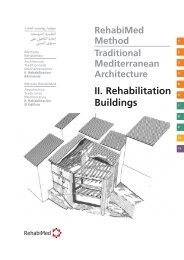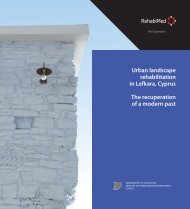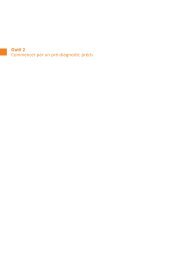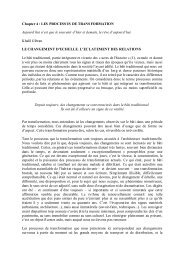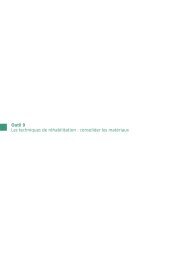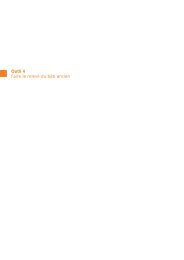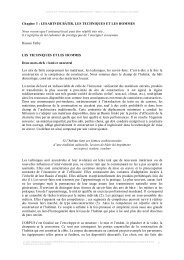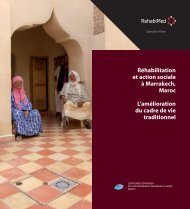La définition d'une stratégie d'intervention. La ... - RehabiMed
La définition d'une stratégie d'intervention. La ... - RehabiMed
La définition d'une stratégie d'intervention. La ... - RehabiMed
Create successful ePaper yourself
Turn your PDF publications into a flip-book with our unique Google optimized e-Paper software.
<strong>La</strong> <strong>définition</strong> d’une <strong>stratégie</strong> d’intervention.<br />
<strong>La</strong> definición de una estrategia de intervención<br />
Defining a strategy for intervention<br />
Usually the settlement and waterfront are more developed at the right<br />
side of river because of the solar exposure.<br />
Coast upland settlement:<br />
This topographic form is typical of volcanic islands and it is generated<br />
by the lava of the volcano in contact to the sea.<br />
Figure 3 shows the settlement of Maia located at the North side of the<br />
island of São Miguel. The urban form is adapted to the surface of the<br />
upland and the geometry tends to be more orthogonal than any other<br />
types here mentioned. This fact happens because of the absence of<br />
territorial constrains.<br />
Coast bay settlement:<br />
The bay is a site which has always been very attractive to the<br />
human settlements. Usually they are important ports and centres of<br />
exchange.<br />
Figure 4 shows the settlement of Baía de São Lourenço located at the<br />
island of Santa Maria. Bays are normally formed by two promontories at<br />
the extremes. Each promontory is associated with a small river where<br />
the settlement starts. With time, the settlements at the extremes are<br />
unified by a path parallel to the contour lines which became the main<br />
street of the urban system. According to the degree of the slope several<br />
parallel and perpendicular streets to the waterfront are settled.<br />
THE URBAN SITE AS A CLIMATE RESPONSE<br />
This elementary typology of urban sites set out for the islands of<br />
Açores can be divided in two main groups: elevations or saliencies and<br />
depressions or recesses. Each topographic site is settled according to its<br />
microclimate conditions.<br />
On the South side of the islands the implementation of the settlement<br />
at recesses prevails. This situation allows combining a good solar<br />
exposure in valleys and bays opened to the rotation of the sun, with a<br />
good protection of the winds from West, more frequent in the winter. For<br />
the same reason, on the North side of the islands the implementation<br />
of settlements at saliencies prevails.<br />
In both situations the orientation of the streets is North – South which<br />
allows a good orientation for the buildings (East – West) protected from<br />
the North and with good ventilation. The churches are systematically<br />
oriented East – West using the sun rise light at the sacred conception<br />
of the space.<br />
BIBLIOGRAPHY<br />
CANIGGIA, G., MAFFEI, G. L. - Il projecto nell’edillizia di base, Marsilio, Veneza, 1984.<br />
CATALDI, Giancarlo. - , Saggi e documenti 6, Biblioteca<br />
di Architettura, Firenze, 1977.<br />
GEIGER, Rudolf – , 2 a Ed.,<br />
Fundação Calouste Gulbenkian, Lisboa, 1990.<br />
GUERREIRO, M. Rosália P. – <br />
. Dissertação de Mestrado, ISCTE, Lisboa, 2002.<br />
GUERREIRO, M. Rosália P. - <br />
, Università Degli Studi, Alinea<br />
Editrice, Florença, 1999.<br />
RIBEIRO, Orlando - , Sá da Costa, 5 a Edição, Lisboa,<br />
1987.<br />
199




